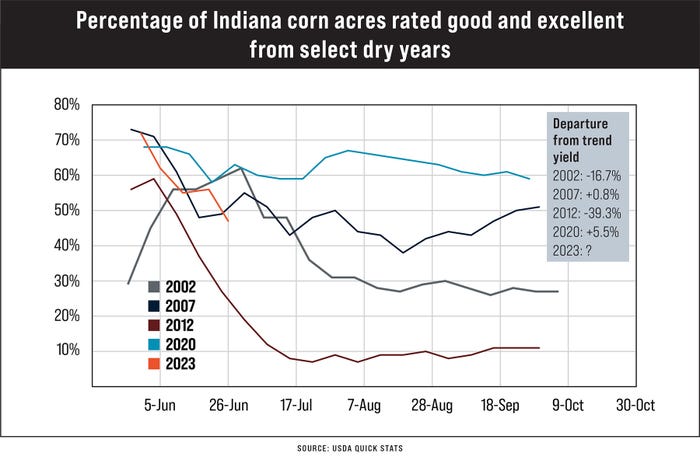July 18, 2023

by Dan Quinn and Tom J. Bechman
How will 2023 compare to other years with dry springs and drought across much of Indiana in the first half of the season? It’s too early to answer that question, but based on corn crop condition ratings published weekly, it’s obvious that 2023 ranked near the lower end of good and excellent crop ratings through June, compared to other years.
Much of the crop condition deteriorated in June due to dry conditions. For example, areas of Tippecanoe County only experienced 0.6 inch of rainfall in June, an 87% decrease from the 30-year average, based on data reported by the Purdue University Mesonet. In addition, crop condition rated good to excellent in Indiana declined from 72% on May 22 to 47% on June 26, based on data from USDA’s National Agricultural Statistics Service in 2023.
The main question often asked is, “How much yield potential am I losing?” It’s a difficult question to answer because the nature of drought varies from one year to another. The graph below highlights that in certain drought years — 2002 and 2012 — large reductions in state corn yield averages occurred in comparison to trend yield.
In other drought years — 2007 and 2020 — state corn yield averages were still at or above trend yield. The unknown factor at this point in the 2023 growing season is how the drought will progress the remainder of the summer.

What climatologists say
“The good news is that in midsummer, it appeared that the drought stabilized,” says Beth Hall, Indiana state ag climatologist. “Basically, that means many areas started getting enough rain to keep up with where they were so that drought conditions didn’t get worse. It’s still not clear if it will stay like that all the way to the end of the season.”
However, except for some southern Indiana counties along the Ohio River and some counties in east-central Indiana, the drought didn’t end with the rains that fell during the first couple of weeks of July.
“The drought was definitely still on over most of the state — especially northwest, west-central and much of central Indiana,” Hall says. “The rains were welcome, but we were so far behind on rainfall for the year that it didn’t nearly bring us out of a deficit.”
Besides, even where rains fell, not everyone was blessed with ample rainfall. “That is typical of summer thunderstorms, and it is definitely playing out this year,” she says. “One area gets a good rain, and right down the road, it doesn’t rain nearly as much.”
Quinn is the Purdue Extension corn specialist.
Read more about:
DroughtYou May Also Like




